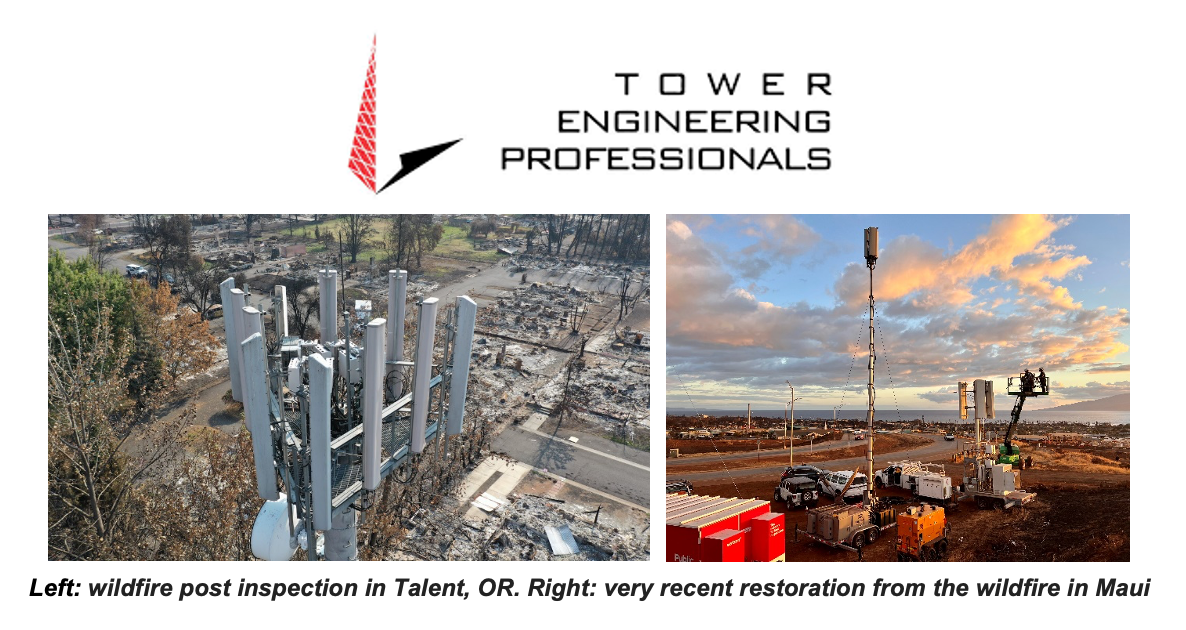Late in August, as Hurricane Idalia barreled up the Gulf Coast, it heralded the beginning of the hurricane season, one in which disaster recovery personnel will be put to the test. Tower Engineering Professionals (TEP), experts in wireless and wireline engineering and construction, is one of those companies that provides disaster recovery services to carriers and tower companies to get wireless services back on air when reliable communications are most imperative.
Preparing before the storms hit is critical. TEP contracts its services in advance of the season at pre-negotiated rates. “We begin preparing to deploy as we track storms ahead of their impact, so we are ready to hit the ground running once the storm passes,” said Trent Johnston, Vice President, TEP.

TEP began performing hurricane, wildfire and other disaster recovery services in the early 2000s. One of the first notable storms where it aided the wireless industry was Katrina, a Category 5 hurricane that resulted in 1,836 fatalities and caused damage between $97.4 billion to $145.5 billion in late August 2005.
“We’ve had some role in cleanup in the aftermath of virtually every hurricane that has impacted the Gulf or East coast, since 2015,” Johnston said.
In 1997, TEP started with two tower-climbing engineers. Today, it has more than 850 professionals providing construction and engineering services. It has branches strategically located from coast to coast. It has 250+ climbers spread across 35 offices covering all of North America.
“Our size, office locations, number of climbers, and diversity of service offerings makes us very well suited to be a one-stop shop for disaster recovery,” Johnston said.

Generally, the area immediately impacted in severe storms will be labeled a “disaster zone” and access is restricted by law enforcement. TEP’s workers have to carry identification indicating that they are critical service providers in order to gain entry to the locations. Beyond that, downed trees, power lines, and flooding all provide impediments to accessing sites.
TEP uses drone flights as a quick and efficient method to gather tower conditions because it allows them to gain situational awareness without risking a tower climb. They’re able to take inventory and ensure there is no critical tower damage that would put their climbers in immediate danger.
“Examples include major tower damage that creates a risk of tower collapse, or carrier equipment up above climbers that has come loose and could potentially fall,” Johnston said.
Structural, Equipment Inspections
As soon as possible, climbers are dispatched in impacted areas. The scope of this service is to perform an inspection to document the condition of the primary structural elements as well as the climbing system. Additionally, an inspection of the equipment and systems on the tower will determine if any damage has occurred to critical communications equipment.
“We also have certified welding inspectors and non-destructive examiners on staff that are available for deployment to check monopole base welds or any other welded structural components,” Johnston said. “Sometimes we deploy crews that clear any downed trees from the access road and make necessary ground improvements to ensure the site is accessible to technicians.”
Generator Refueling
Power is often knocked out during hurricanes, so generator power becomes critical. To provide generator refueling, TEP will have multiple trucks with large fuel storage tanks ready prior to entering the impacted area. Crews and trucks are dispatched to each site to refuel the backup generators and ensure they remain running.
“Generally, towers have enough fuel storage onsite to last a day or two. With severe storms causing long commercial power outages, keeping the on-site generator fueled and running is critical to keeping the network up. We can also haul and set up portable generators for sites that are not hardened,” Johnston said.
Tower Maintenance Repairs
After visiting the site for the initial inspection, TEP’s tower maintenance crews make critical structural repairs to ensure the stability of the structure. They also fix loose mounts, antennas, radios, and address any water damage to connectors.
“Typical repairs include repair of bent members, safety climb replacement, securing loose equipment that could pose a falling hazard, removal of wind-blown debris, and ground improvements due to erosion,” Johnston said.
Antenna System Maintenance Repairs
TEP has line and antenna maintenance crews (tiger teams) nationwide that are deployed to get the site back on air, once major structural concerns are addressed and power is restored.
“Technicians are available to troubleshoot alarms or replace damaged equipment to get the site back on air,” Johnston said. “Typical repairs include azimuth/downtilt adjustment, securing loose, aerial fiber or unsupported equipment as well as jumper, antenna, and radio replacement.”
Other tower structure maintenance repairs that TEP’s technicians will perform after a storm include fixing damaged tower members from flying debris, loose mounts or antennas or radios, and damaged safety climbs. Guyed towers will often suffer tension, twist, and plumb issues.
The Preparation
Crews of technicians are located strategically throughout the U.S. — especially the Southeast — so that they can reach damaged tower sites quickly. Spare parts are warehoused and carried to the scene so they have replacements on hand. The tanks of generator refueling trucks have to be full. Preparation cannot wait until the storm hits land. With more than two decades of storm and disaster recovery, TEP knows that firsthand.
For more information, contact Trent Johnston at (919) 661-6351 or via email at [email protected].
By J. Sharpe Smith, Inside Towers Technology Editor




Reader Interactions